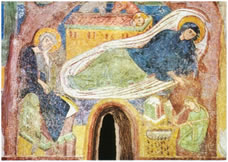Painting techniques
Egg tempera painting, in which the pigment was mixed with water and egg before application, was well established by the 13th century. The dried protein remaining after the water evaporated bound the pigment to the substrate. The tendency of a thick layer of such paint to crack meant that it was essential to apply the paint in thin layers or glazes, and is the reason for the highly finished appearance of medieval paintings.
High Romanesque style
Nativity, chapel of the Appiano castle (Italy), XII century.
The interior walls of the Castle Chapel, a small hall church of Castel Appiano in the north of Italy, are entirely covered with paintings. The paintings reflect the predominant Veneto-Byzantine influence on the High Romanesque style. Ultramarine was used by the artist for painting the Virgin’s cloak.
Palette
Mineral pigments (red ochre, yellow ochre, umber, lime white) continued to be used by painters throughout the Middle Ages. Dug right out of the earth and shaped into sticks with knives, painters made chalks ready for drawing. Natural red chalks, with their rich, warm color, were popular from about 1500 to 1900. Such artists as Michelangelo, Rembrandt, and Antoine Watteau used this medium to produce some of the most revered drawings in the world today.
Available since antiquity, medieval Italian painters used green earth for under painting flesh tones. Its commonly used synonym is Verona green, from Verona, a city in the north part of Italy. Malachite and verdigris were also used as greens. Orpiment continued to be used for yellow together with yellow ochre.
In addition to azurite, which had been used as a blue since the time of the ancient Egyptians, by far the most important blue in the Middle Ages was ultramarine. During the Renaissance, the color blue was associated with purity, and ultramarine was used to striking effect in paintings of the Virgin Mary, where she was almost invariably depicted wearing ultramarine blue garments. The high price of the pigment, sourced in Afghanistan, also meant that its use was appropriate in the case of a noble subject such as the mother of Christ.

